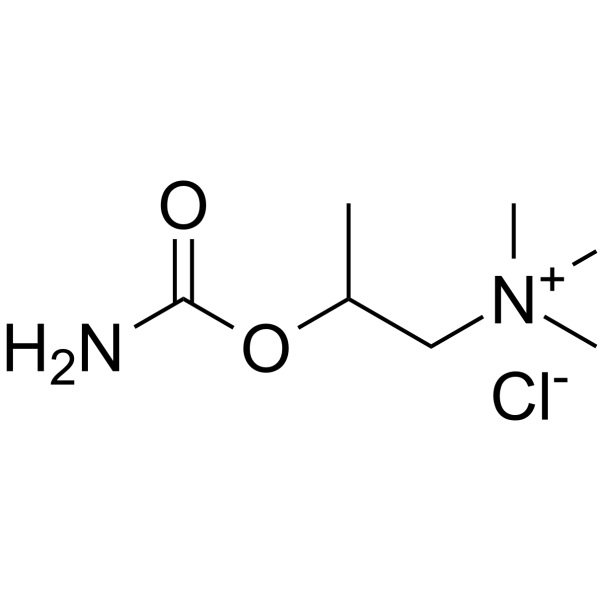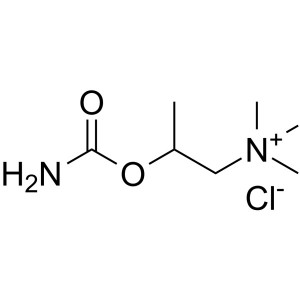Bethanechol Chloride CAS 590-63-6 Assay 98.0%-101.5% Factory
Shanghai Ruifu Chemical Co., Ltd. is the leading manufacturer of Bethanechol Chloride (CAS: 590-63-6) with high quality. Selective muscarinic receptor agonist; AChR.
Ruifu Chemical has been supplying pharmaceutical intermediates and APIs more than 15 years.
Ruifu Chemical can provide worldwide delivery, competitive price, excellent service.
Purchase Bethanechol Chloride or other products, please contact us by e-mail: alvin@ruifuchem.com
| Chemical Name | Bethanechol Chloride |
| Synonyms | Carbamyl-β-Methylcholine Chloride; Carbamyl-beta-Methylcholine Chloride; (2-Carbamoyloxypropyl)trimethylammonium Chloride |
| Stock Status | In Stock, Commercial Production |
| CAS Number | 590-63-6 |
| Molecular Formula | C7H17ClN2O2 |
| Molecular Weight | 196.68 g/mol |
| Melting Point | 211.0-219.0℃ |
| Store Under Inert Gas | Store Under Inert Gas |
| Sensitive | Hygroscopic, Heat Sensitive |
| Solubility | Slightly Soluble in Ethanol |
| Storage Temperature | Store Long-Term at 2-8℃ |
| Shipping Conditions | Ambient Temperature |
| COA & MSDS | Available |
| Origin of Product | Shanghai, China |
| Product Categories |
API (Active Pharmaceutical Ingredient) |
| Caution | Not For Human or Veterinary Use. For Research Use Only. |
| Brand | Ruifu Chemical |
| Items | Specifications | Results |
| Appearance | White Crystalline or Crystalline Powder | Conforms |
| Melting Point | 211.0-219.0℃ | 212.0-215.0℃ |
| Residual Solvents | ≤0.50% | 0.30% |
| Tapped Density | 0.45-0.75 | 0.65 |
| Powder Size | 100.0% Passes Through 40 Mesh Sieve | Conforms |
| pH | 5.50-6.50 | 6.14 |
| Chloride Content | 17.70-18.30% | 18.05% |
| Loss on Drying | ≤1.00% (105℃ for 2 Hours) | 0.53% |
| Residue on Ignition | ≤0.10% | 0.04% |
| Heavy Metals | ≤0.003% | <0.003% |
| Related Substances | ||
| 2-Hydroxypropyltrimethyl Ammonium | ≤1.00% | 0.4% |
| Single Maximum Unknown Impurity | ≤0.10% | 0.06% |
| Total Impurities | ≤1.50% | 0.97% |
| Assay / Analysis Method | 98.0%-101.5% | 99.8% |
| Infrared Spectrum | Conforms to Structure | Conforms |
| Conclusion | Has been tested and complies with the USP35 Standard | |
Bethanechol Chloride
C7H17ClN2O2 196.67
1-Propanaminium, 2-(aminocarbonyl)oxy-N,N,N-trimethyl-, chloride, (±)-.
(±)-(2-Hydroxypropyl)trimethylammonium chloride carbamate [590-63-6].
» Bethanechol Chloride contains not less than 98.0 percent and not more than 101.5 percent of C7H17ClN2O2, calculated on the dried basis.
Packaging and storage- Preserve in tight containers.
USP Reference standards <11>-
USP Bethanechol Chloride RS
Identification-
A: Infrared Absorption <197M>.
B: Dissolve about 50 mg in 2 mL of water, add 0.1 mL of cobaltous chloride solution (1 in 100), then add 0.1 mL of potassium ferrocyanide TS: an emerald-green color is produced, and almost entirely fades in 5 to 10 minutes (distinction from choline chloride, which gives the same reaction but the color does not fade).
C: To 1 mL of a solution (1 in 100) add 0.1 mL of iodine TS: a brown precipitate is formed, and it rapidly changes to a dark olive-green color.
D: A solution of it responds to the tests for Chloride <191>.
pH <791>: between 5.5 and 6.5, in a solution (1 in 100).
Loss on drying <731>- Dry it at 105 for 2 hours: it loses not more than 1.0% of its weight.
Residue on ignition <281>: not more than 0.1%.
Heavy metals, Method I <231>- Dissolve 667 mg in 10 mL of water, add 2 mL of 1 N acetic acid, and dilute with water to 25 mL: the limit is 0.003%.
Chloride content- Dissolve about 400 mg, previously dried and accurately weighed, in 30 mL of water. Add 40.0 mL of 0.1 N silver nitrate VS, then add 3 mL of nitric acid and 5 mL of nitrobenzene, shake for a few minutes, add 2 mL of ferric ammonium sulfate TS, and titrate the excess silver nitrate with 0.1 N ammonium thiocyanate VS. Each mL of 0.1 N silver nitrate is equivalent to 3.545 mg of Cl: the content of Cl is between 17.7% and 18.3%.
Related compounds-
Buffer solution- Transfer about 0.48 g of methanesulfonic acid to a 1000-mL volumetric flask. Dissolve in and dilute with water to volume.
Mobile phase- Prepare a filtered and degassed mixture of Buffer solution and acetonitrile (95:5). Make adjustments if necessary (see System Suitability under Chromatography <621>).
Standard solution- Dissolve an accurately weighed quantity of USP Bethanechol Chloride RS in Mobile phase, and dilute quantitatively, and stepwise if necessary, with Mobile phase to obtain a solution having a known concentration of about 1 µg of USP Bethanechol Chloride RS per mL.
Test solution- Transfer about 25 mg of Bethanechol Chloride, accurately weighed, to a 250-mL volumetric flask. Dissolve in and dilute with Mobile phase to volume, and mix.
System suitability solution- Transfer about 25 mg of Bethanechol Chloride, accurately weighed, to a 250-mL volumetric flask. Add 10 mL of 0.1 N sodium hydroxide, and allow to stand for about 15 minutes. Add 10 mL of 0.1 N hydrochloric acid. Dissolve in and dilute with Mobile phase to volume, and mix.
Chromatography system (see Chromatography <621>)- The liquid chromatograph is equipped with a conductivity detector and a 3.9- × 150-mm column containing packing L55. The flow rate is about 1.0 mL per minute. The detector and column temperatures are maintained at 35 and 30, respectively. Chromatograph the System suitability solution, and record the peak responses as directed for Procedure: the relative retention time is about 0.9 for 2-hydroxypropyltrimethyl ammonium chloride and 1.0 for bethanechol; the resolution, R, between 2-hydroxypropyltrimethyl ammonium chloride and bethanechol is not less than 0.8. Chromatograph the Standard solution, and record the peak responses as directed for Procedure: the relative standard deviation for replicate injections is not more than 10.0% for bethanechol chloride.
Procedure- Separately inject equal volumes (about 50 µL) of the Mobile phase, the Standard solution, and the Test solution into the chromatograph, record the chromatograms, and measure the peak responses for all the peaks. Calculate the percentage of each impurity in the portion of Bethanechol Chloride taken by the formula:
25,000C(F/W)(ri / rS)
in which C is the concentration, in mg per mL, of USP Bethanechol Chloride RS in the Standard solution; F is the relative response factor and is equal to 0.79 for 2-hydroxypropyltrimethyl ammonium chloride and 1.0 for any other impurity; W is the weight, in mg, of Bethanechol Chloride taken to prepare the Test solution; ri is the peak response for any impurity in the Test solution; and rS is the peak response of USP Bethanechol Chloride RS in the Standard solution. Not more than 1.0% of 2-hydroxypropyltrimethyl ammonium is found; not more than 0.1% of any other impurity is found; and the sum of all the impurities is not more than 1.5%.
Assay-
Buffer solution- Transfer about 29 mg of edetic acid to a 1000-mL volumetric flask, and dissolve in 500 mL of water. Add 300 µL of nitric acid to the volumetric flask, and dilute with water to volume. Pass through a 0.45-µm nylon membrane filter.
Mobile phase- Prepare a filtered and degassed mixture of Buffer solution and acetonitrile (95:5). Make adjustments if necessary (see System Suitability under Chromatography <621>).
System suitability solution- Transfer about 25 mg of Bethanechol Chloride, accurately weighed, to a 250-mL volumetric flask. Add 10 mL of 0.1 N sodium hydroxide, and allow to stand for about 15 minutes. Add 10 mL of 0.1 N hydrochloric acid. Dissolve in and dilute with Mobile phase to volume, and mix.
Standard preparation- Dissolve an accurately weighed quantity of USP Bethanechol Chloride RS in Mobile phase, and dilute quantitatively, and stepwise if necessary, with Mobile phase to obtain a solution having a known concentration of about 0.1 mg of USP Bethanechol Chloride RS per mL.
Assay preparation- Transfer about 25 mg of Bethanechol Chloride, accurately weighed, to a 250-mL volumetric flask. Dissolve in and dilute with Mobile phase to volume, and mix.
Chromatographic system (see Chromatography <621>)- The liquid chromatograph is equipped with a conductivity detector and a 3.9- × 150-mm column containing packing L55. The flow rate is about 1.0 mL per minute. The detector and column temperatures are maintained at 35 and 30, respectively. Chromatograph the System suitability solution, and record the peak responses as directed for Procedure: the relative retention times are about 0.9 for 2-hydroxypropyltrimethyl ammonium chloride and 1.0 for bethanechol; and the resolution, R, between 2-hydroxypropyltrimethyl ammonium chloride and bethanechol is not less than 0.8. Chromatograph the Standard preparation, and record the peak responses as directed for Procedure: the tailing factor is not more than 3.5; and the relative standard deviation for replicate injections is not more than 3.0%.
Procedure- Separately inject equal volumes (about 25 µL) of the Standard preparation and the Assay preparation into the chromatograph, record the chromatograms, and measure the peak responses. Calculate the quantity, in mg, of C7H17ClN2O2 in the portion of Bethanechol Chloride taken by the formula:
250C(rU / rS)
in which C is the concentration, in mg per mL, of USP Bethanechol Chloride RS in the Standard preparation; and rU and rS are the bethanechol chloride peak responses obtained from the Assay preparation and the Standard preparation, respectively.
Package: Bottle, Aluminium foil bag, 25kg/cardboard drum, or according to customer's requirement.
Storage Condition: Keep the container tightly closed and store in a cool, dry (2~8℃), well-ventilated warehouse away from incompatible substances. Keep away from sunshine; avoid fire and heat sources; avoid moisture.
Shipping: Deliver to worldwide by air, by FedEx / DHL Express. Provide fast and reliable delivery.
How to Purchase? Please contact Dr. Alvin Huang: sales@ruifuchem.com or alvin@ruifuchem.com
15 Years Experience? We have more than 15 years of experience in the manufacture and export of a wide range of high quality pharmaceutical intermediates or fine chemicals.
Main Markets? Sell to domestic market, North America, Europe, India, Korea, Japanese, Australia, etc.
Advantages? Superior quality, affordable price, professional services and technical support, fast delivery.
Quality Assurance? Strict quality control system. Professional equipment for analysis include NMR, LC-MS, GC, HPLC, ICP-MS, UV, IR, OR, K.F, ROI, LOD, MP, Clarity, Solubility, Microbial limit test, etc.
Samples? Most products provide free samples for quality evaluation, shipping cost should be paid by customers.
Factory Audit? Factory audit welcome. Please make an appointment in advance.
MOQ? No MOQ. Small order is acceptable.
Delivery Time? If within stock, three days delivery guaranteed.
Transportation? By Express (FedEx, DHL), by Air, by Sea.
Documents? After sales service: COA, MOA, ROS, MSDS, etc. can be provided.
Custom Synthesis? Can provide custom synthesis services to best fit your research needs.
Payment Terms? Proforma invoice will be sent first after confirmation of order, enclosed our bank information. Payment by T/T (Telex Transfer), PayPal, Western Union, etc.
| Hazard Symbols | Xn - Harmful |
| Risk Codes | 22 - Harmful if swallowed |
| Safety Description | 36 - Wear suitable protective clothing |
| WGK Germany | 3 |
| RTECS | BR5425000 |
| TSCA | Yes |
| HS Code | 2924199090 |
Bethanechol Chloride (CAS: 590-63-6) is a selective muscarinic receptor agonist.
Bethanechol Chloride is an ester-type parasympathomimetic drug used in the treatment of gastrointestinal disorders. It is a cholinergic agonist that acts on muscarinic receptors, inducing smooth muscle contraction and increasing gastric secretions. Its applications range from gastrointestinal studies to bladder function research, making it an essential tool in the field.
Bethanechol Chloride is a cholinergic used to increase bladder contractions when the bladder has been weakened or when the bladder cannot completely empty. It may also be effective in increasing the movement of the esophagus. Bethanechol Chloride has a strong stimulating effect on smooth muscle. It can stimulate smooth muscle, promote gastrointestinal peristalsis, promote body fluid secretion, increase appetite and help digestion.


